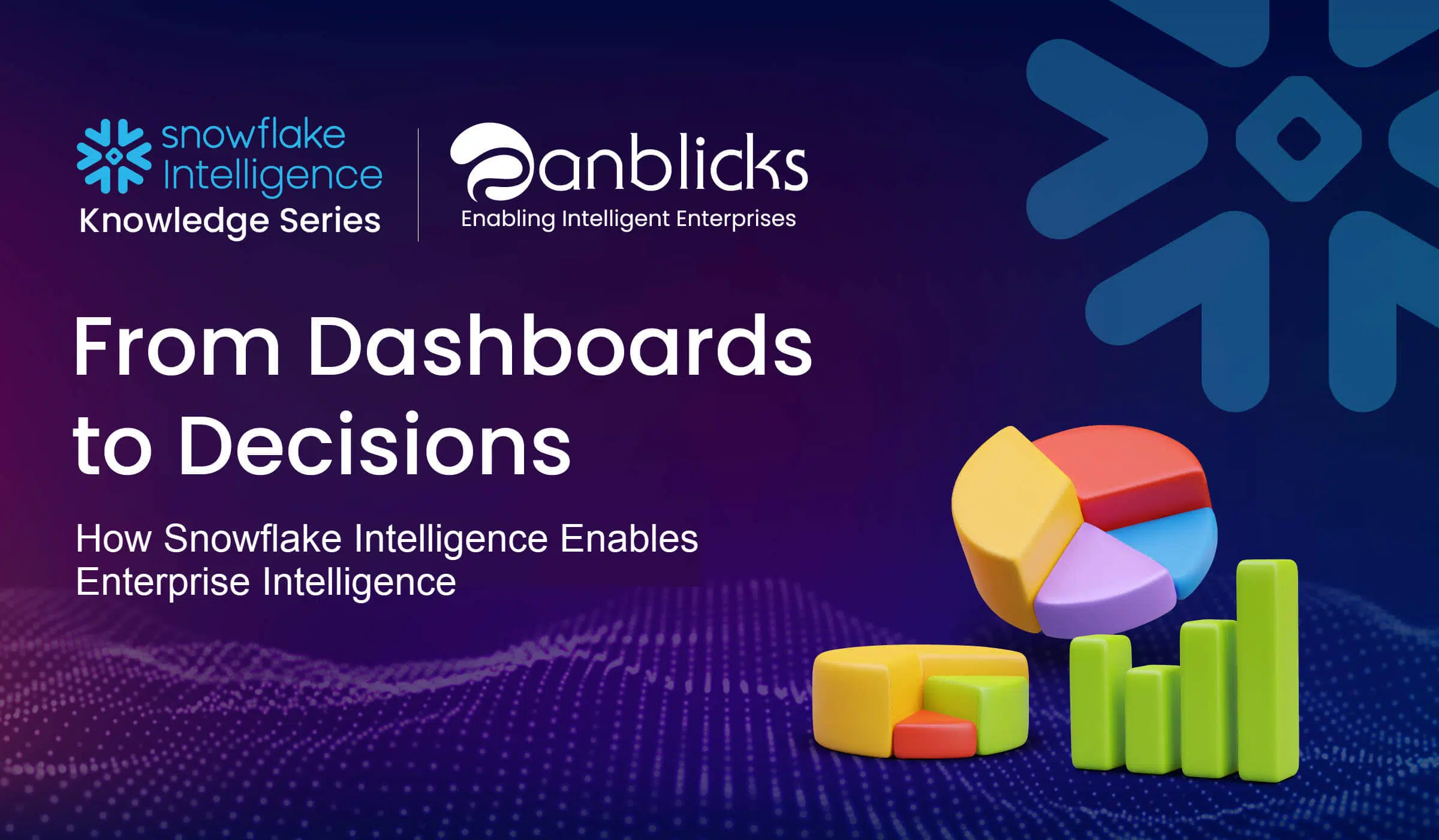
From Dashboards to Decisions: How Snowflake Intelligence Enables Enterprise Intelligence

The Analytics Plateau
Over the past decade, organizations have invested heavily in building data platforms, dashboards, and business intelligence tools.
We now have more visibility than ever—but also, more frustration.
Dashboards tell us what happened but rarely why it happened or what to do next. In meeting after meeting, executives look at charts, identify anomalies, and then assign teams to “dig deeper.” By the time the analysis is complete, the opportunity to act has passed.
This was the era before Intelligent decisioning, where data informs but doesn’t decide, and insights travel slower than business reality.
Snowflake Intelligence marks a turning point in this story. Using AI Agents, it enables enterprises from observing data to conversing with it—and ultimately, acting on it in real time.

Figure: Snowflake Intelligence intuitive user interface for asking business questions.
A Real-World Challenge: The Case of TrendMart Inc.
To understand how Snowflake Intelligence reshapes decision-making, let’s look at a realistic scenario.
TrendMart Inc.—an imaginary but representative global retail organization—sells a broad range of fashion and lifestyle products through hundreds of stores and a fast-growing e-commerce platform. Its story is fictional, but the challenges it faces are shared by countless enterprises today.
Like many modern retailers, TrendMart has invested heavily in dashboards. Every week, executives gather around these dashboards to review performance metrics, hoping to catch early signs of market shifts or operational issues.
One Monday morning, the team notices something troubling:
“Online revenue is down 12% week-over-week.”
The dashboards show the decline—but not the reason. Analysts are tasked to investigate. Over the next two days, they dug into sales logs, marketing data, and supplier records. Eventually, they trace the issue to a delayed shipment from a top supplier, which caused low inventory for TrendMart’s best-selling outdoor products.
By the time the insight surfaces, the week—and the lost revenue—are already gone.This is the reality for many enterprises today: even with modern data platforms, decisions still lag behind insights. Business users can see what’s wrong, but it can’t respond fast enough.
That’s where Snowflake Intelligence could enter the picture. It doesn’t just display anomalies—it interprets them, correlates root causes across structured and unstructured data and recommends or initiates the next best action.
In the following sections, we’ll explore how TrendMart could achieve the next evolution of business intelligence, which is Enterprise Intelligence —by architecting a decision-first data environment powered entirely by the Snowflake ecosystem.
The Road to Enterprise Intelligence
TrendMart’s challenge is not unusual. Most enterprises today are excellent at reporting what has happened but struggle to understand and respond at the moment.
To break this cycle, Anblicks (Snowflake’s ELITE partner), guided TrendMart to evolve from traditional analytics toward what it might call decision intelligence — a model where data is continuously analyzed, explained, and acted upon through intelligent agents.
Transitioning to this model wouldn’t be a single leap — it could happen through a series of deliberate, connected steps.
Each step could build on the last, combining Snowflake’s data foundation with the emerging capabilities of Snowflake Intelligence.
What follows is that journey, step by step — from the first foundational changes to a fully autonomous decision ecosystem.
Snowflake Intelligence Architecture: From Data to Decisions
Before TrendMart could activate intelligence, it needed to architect the environment that would make real-time, explainable decisioning possible.
At a high level, the architecture would bring together Snowflake’s unified data platform, Cortex AI services, and Intelligence Agents under a single governance and security layer. The result would be a decision ecosystem that connects data ingestion, modeling, reasoning, and action without data ever leaving Snowflake.

Step 1: Building the Unified Data Foundation
Before Snowflake Intelligence can reason, explain, or act—it needs data that speaks the same language. For TrendMart, that will begin with consolidating all operational, customer, and supply chain data into a single, governed Snowflake environment.
Bringing Data Together
TrendMart’s business runs on dozens of disconnected systems. Each holds valuable fragments of the truth:
Structured data:
- Sales and order transactions – store and e-commerce performance by SKU, region, and channel.
- Inventory and supply chain – stock levels, purchase orders, shipments, and supplier lead times.
- Pricing and promotions – campaign calendars, markdowns, discount codes, and price changes.
- Web and app analytics – session counts, conversion funnels, and checkout errors.
- Marketing and advertising spend – cross-channel performance, ROAS, and attribution data.
- Customer and returns data – purchase behavior, return reasons, and satisfaction metrics.
Unstructured data
- Supplier communications – emails, PDFs, and portal messages highlighting shipment or production delays.
- Logistics and carrier updates – exception reports, weather-related delays, and warehouse alerts.
- Customer feedback – support tickets, chat transcripts, and product reviews.
- Internal operations notes – incident reports, merchandising briefs, and store manager updates.
Ingesting and Modeling Data in Snowflake
Once we identify the structured and unstructured data sources, the next step would be to bring everything into Snowflake in a unified and governed way. Using Snowpipe and Snowpipe Streaming data from sales, inventory, marketing, logistics, and customer systems is ingested continuously ensuring that both transactional and contextual updates flow into the platform in near real time. We can also leverage Snowflake’s OpenFlow for turbo charging ETL for AI.
We will organize its data using the Medallion (Bronze, Silver, Gold) architecture inside Snowflake. In the Bronze layer, raw data from all sources will be ingested via Snowpipe in its native form for full traceability. The Silver layer will use Snowpark, Streams, and Tasks to cleanse, standardize, and harmonize this data—resolving product codes, supplier IDs, and linking sales, marketing, and logistics datasets. Finally, the Gold layer will transform this refined data into business-ready models such as revenue health, stock-out risk, supplier performance, and customer satisfaction—forming the foundation on which Snowflake Intelligence and Cortex services perform reasoning, retrieval, and decisioning.
This unified data model will enable TrendMart to correlate structured metrics with unstructured signals—such as supplier delays or customer complaints—so analysts and intelligence agents can answer complex questions like “Why is online revenue down 12% week-over-week?” in real time, using a single, trusted Snowflake environment.
Step 2: Setting Up Snowflake Intelligence
With TrendMart’s unified data foundation in place, the next step will be to activate Snowflake Intelligence – the native AI layer that powers reasoning, retrieval, and conversational analysis directly within the Snowflake Data Cloud.
Snowflake Intelligence combines three key components that work together to interpret and explain business data:
- Cortex Analyst – for natural-language reasoning over structured data.
- Cortex Search – for semantic retrieval from unstructured content.
- Snowflake Intelligence Configuration – the platform setup that connects both services within your account.
Below are the high-level steps to follow to set up these capabilities. For detailed configuration and syntax, refer to the official Snowflake documentation linked under each step.
2.a) Enable and Configure Snowflake Intelligence
Purpose: Activate the intelligence layer that hosts Cortex Analyst and Cortex Search within your Snowflake account.
High-Level Steps:
- In Snowsight, navigate to AI & ML ▸ Snowflake Intelligence and enable the feature (available in supported regions).
- Assign appropriate roles (e.g., CORTEX_USER) and warehouses for intelligence workloads.
- Confirm access to the AI and ML menu options to manage Cortex services.
- Verify connectivity and resource allocation within the account.
Why It Matters: This activation ensures all AI services run natively inside Snowflake, avoiding data movement while maintaining full governance.
Documentation: Snowflake Intelligence Overview
2.b) Configure Cortex Analyst – Structured Reasoning
Purpose: Allow natural-language queries across TrendMart’s structured data (sales, inventory, marketing, and supplier performance models).
High-Level Steps:
- Define Semantic Models or Semantic Views on curated Gold-layer tables (e.g., gold_revenue_health, gold_supplier_performance).
- Map business-friendly terms such as “online revenue,” “supplier delay,” and “promotion impact” to corresponding columns and metrics.
- Assign access roles and test natural-language queries in Snowsight (“Which suppliers caused the revenue decline last week?”).
- Validate query translation and result accuracy, then publish the model for enterprise use.
Why It Matters: This enables analysts to reason over data conversationally, reducing SQL complexity while preserving governance.
Documentation: Cortex Analyst Guide
2.c) Configure Cortex Search – Unstructured Context Retrieva
Purpose: Index and query unstructured and semi-structured data (supplier emails, logistics reports, support tickets, customer reviews) to complement structured analysis.
High-Level Steps:
- Create Search Collections for each document type and store files in Snowflake stages or external volumes.
- Tag each document with relevant business metadata (SKU, supplier, region, date).
- Enable continuous indexing so that new or updated documents are searchable in near real time.
- Test natural-language retrieval queries (“Show recent supplier messages about delayed outdoor shipments”).
Why It Matters: Cortex Search provides contextual explanations that connect operational details to performance metrics—for example, linking a revenue dip to shipment delay emails or negative customer reviews.
Documentation: Cortex Search Overview
By completing these configurations, TrendMart can transform the solution from a reporting platform into an intelligent, conversational data ecosystem—one that can reason over structured and unstructured data together and provide contextual insights on demand.
Step 3: From Question to Answer
`With the foundation and Snowflake Intelligence components in place, TrendMart’s business users can now converse directly with their data. Instead of logging into a dashboard or writing SQL, they simply open the Snowflake Intelligence app in Snowsight and ask a natural question:
“Why is online revenue down 12% week-over-week?”
Here’s what will happen behind the scenes.
3.a) Query Understanding and Routing
When the question is submitted, Snowflake Intelligence interprets its intent using natural language understanding. The platform automatically determines which services are best suited to answer:
- Cortex Analyst for structured data reasoning.
- Cortex Search for contextual unstructured insights.
Snowflake Intelligence identifies relevant datasets and search collections configured in Step 2 — such as Gold-layer sales and inventory models, and supplier communication documents — and routes the request accordingly.
3.b) Structured Analysis with Cortex Analyst
Cortex Analyst translates the question into optimized SQL queries that execute within Snowflake, against TrendMart’s governed data.
- It queries the gold_revenue_health model to confirm that online revenue dropped 12% compared to the previous week.
- It segments the decline by category, region, and SKU, identifying that the Outdoor Gear category in Region A accounts for most of the loss.
- It further correlates data from the gold_supplier_performance table, revealing that multiple SKUs in this category are tied to Supplier SK102, whose shipment timeliness dropped significantly.
At this point, Cortex Analyst produces a quantitative explanation — a factual summary of what happened and where.
3.c) Contextual Retrieval with Cortex Search
To uncover why it happened, Snowflake Intelligence automatically triggers Cortex Search across unstructured sources.
- It searches within indexed supplier communications and logistics reports linked to Supplier SK102 and Region A.
- Cortex Search retrieves several emails and PDF reports containing the phrases “shipment delay” and “warehouse backlog” dated two days before the sales decline.
- It also finds recent customer support tickets complaining about “out-of-stock outdoor items.”
These retrieved snippets are summarized by the Intelligence layer and matched to the structured insights from Cortex Analyst.
3.d) Response Generation and Explanation
Snowflake Intelligence combines both streams of reasoning — structured metrics from Cortex Analyst and contextual evidence from Cortex Search — into a unified, human-readable answer:
“Online revenue declined 12% week-over-week, primarily in the Outdoor Gear category (Region A). The drop is linked to delayed shipments from Supplier SK102, which caused temporary stock-outs on five top-selling SKUs. Supplier emails dated October 20 mention a warehouse backlog that delayed replenishment.”
Users can expand the explanation to view supporting tables, key metrics, or original source snippets — all within Snowflake, governed and auditable.
3.e) Continuous Learning and Decision Support
Every interaction helps the system learn context and refine relevance. Analysts can thumbs-up or adjust answers, improving term mappings in Cortex Analyst or metadata tagging in Cortex Search. Over time, Snowflake Intelligence evolves from answering questions to recommending next steps — such as triggering alerts to the supply-chain team or suggesting proactive stock reallocation.
Conclusion: From Dashboards to Decisions
We began with a familiar challenge — the Analytics Plateau, where dashboards inform but rarely decide. TrendMart’s journey shows how Snowflake Intelligence breaks through that ceiling, unifying data, reasoning, and action in a single governed platform.
By combining Cortex Analyst for structured reasoning and Cortex Search for contextual understanding, Snowflake transforms analytics from a retrospective process into a living, conversational system. Business users no longer wait for static reports — they ask questions, get explanations, and act instantly.
And this is just the beginning. Enterprises can extend this architecture further by:
- Building custom apps that call Intelligence Agents via API to embed insights directly into business workflows.
- Scheduling checks and alerts through Agent API calls for continuous monitoring and anomaly detection.
- Integrating decision automation across operations, supply chain, and marketing — all without leaving the Snowflake ecosystem.
In short, Snowflake Intelligence can help you evolve from business intelligence to Enterprise Intelligence. It doesn’t just tell you what happened — it helps you understand why it happened and what to do next — turning every question into a decision, and every decision into action.

As a Chief Innovation Officer, Samir Bhatt leads innovation and AI initiatives at Anblicks, focusing on developing data-driven solutions that create real business value. With over 25 years in the IT industry, he brings deep expertise in technology strategy, cloud, and intelligent applications. Samir guides the Snowflake Center of Excellence at Anblicks in building reusable assets and data modernization frameworks that accelerate customer success.



